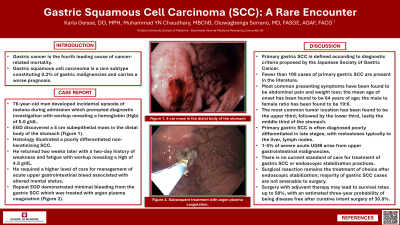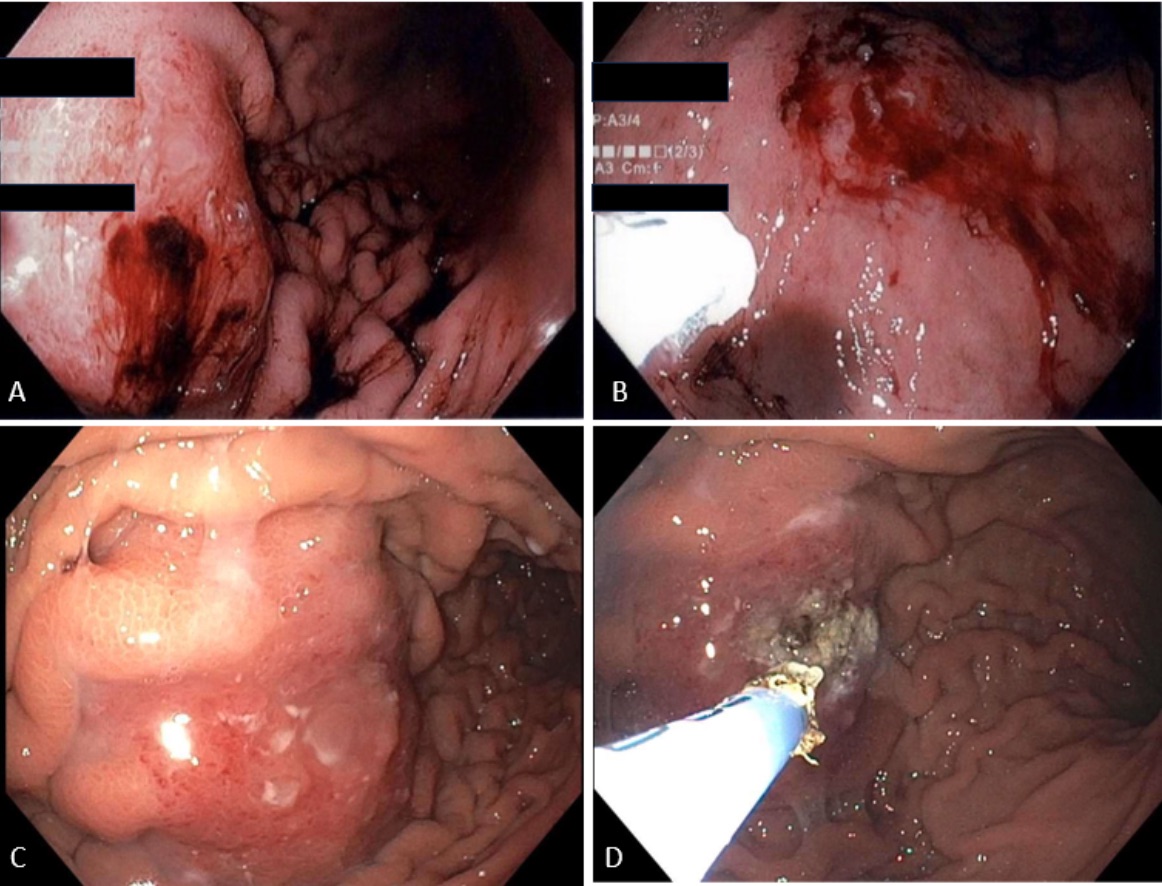Monday Poster Session
Category: Stomach
P3372 - Gastric Squamous Cell Carcinoma (SCC): A Rare Encounter
Monday, October 28, 2024
10:30 AM - 4:00 PM ET
Location: Exhibit Hall E

Has Audio
- KG
Karla Geisse, DO, MPH
Indiana University School of Medicine
Evansville, IN
Presenting Author(s)
Karla Geisse, DO, MPH1, Muhammad YN. Chaudhary, MBChB2, Oluwagbenga Serrano, MD, FACG3
1Indiana University School of Medicine, Evansville, IN; 2Indiana University Southwest, Evansville, IN; 3Good Samaritan Hospital, Vincennes, IN
Introduction: Gastric cancer is the fourth leading cause of cancer-related mortality, with adenocarcinoma being the most common histological subtype. Gastric SCC is a rare subtype constituting 0.2% of gastric malignancies and carrying a worse prognosis. We report a case of a 76-year-old man who was found to have gastric SCC leading to severe anemia.
Case Description/Methods: A 76-year-old man with a past medical history including stroke and deep vein thrombosis, requiring anticoagulation with rivaroxaban, presented to the emergency department (ED) for left eye deviation and left upper extremity weakness. During the hospital admission, a spontaneous episode of melena prompted diagnostic investigation. Workup revealed a hemoglobin (Hgb) of 5.0 g/dL. He was resuscitated with packed red blood cells (pRBCs). Esophagogastroduodenoscopy (EGD) discovered a 4cm subepithelial mass in the distal body of the stomach, which was biopsied (Figure 1 A, B). The patient stabilized and was discharged with close clinic follow-up. Histology illustrated a poorly differentiated non-keratinizing SCC. The patient returned to the ED two weeks later with a two-day history of weakness and fatigue. Workup revealed a Hgb of 4.8 g/dL, rising to 8.7 g/dL with additional pRBCs. The patient required a higher level of care for management of acute upper gastrointestinal bleed (UGIB) associated with altered mental status. At the outside hospital, his Hgb remained stable and repeat EGD demonstrated minimal bleeding from the gastric SCC; it was treated with argon plasma coagulation (APC) (Figure 1 C, D). The patient opted for hospice care after discussion of treatment goals.
Discussion: This case identifies a rare malignancy, presenting atypically. Only 1-5% of severe acute UGIB arise from upper gastrointestinal malignancies. This case shows a rare subtype of malignancy whose bleeding was acutely managed with APC. There is no current standard of care for gastric SCC or endoscopic stabilization practices specifically. Despite late presentation and metastatic disease, surgical resection remains the treatment of choice after endoscopic stabilisation. Surgery with adjuvant therapy may lead to survival rates up to 50%, with an estimated three-year probability of being disease free after curative intent surgery of 30.8%. However, majority of gastric SCC cases are not amenable to surgery. Our patient was not considered for surgical intervention as he opted for hospice care.

Disclosures:
Karla Geisse, DO, MPH1, Muhammad YN. Chaudhary, MBChB2, Oluwagbenga Serrano, MD, FACG3. P3372 - Gastric Squamous Cell Carcinoma (SCC): A Rare Encounter, ACG 2024 Annual Scientific Meeting Abstracts. Philadelphia, PA: American College of Gastroenterology.
1Indiana University School of Medicine, Evansville, IN; 2Indiana University Southwest, Evansville, IN; 3Good Samaritan Hospital, Vincennes, IN
Introduction: Gastric cancer is the fourth leading cause of cancer-related mortality, with adenocarcinoma being the most common histological subtype. Gastric SCC is a rare subtype constituting 0.2% of gastric malignancies and carrying a worse prognosis. We report a case of a 76-year-old man who was found to have gastric SCC leading to severe anemia.
Case Description/Methods: A 76-year-old man with a past medical history including stroke and deep vein thrombosis, requiring anticoagulation with rivaroxaban, presented to the emergency department (ED) for left eye deviation and left upper extremity weakness. During the hospital admission, a spontaneous episode of melena prompted diagnostic investigation. Workup revealed a hemoglobin (Hgb) of 5.0 g/dL. He was resuscitated with packed red blood cells (pRBCs). Esophagogastroduodenoscopy (EGD) discovered a 4cm subepithelial mass in the distal body of the stomach, which was biopsied (Figure 1 A, B). The patient stabilized and was discharged with close clinic follow-up. Histology illustrated a poorly differentiated non-keratinizing SCC. The patient returned to the ED two weeks later with a two-day history of weakness and fatigue. Workup revealed a Hgb of 4.8 g/dL, rising to 8.7 g/dL with additional pRBCs. The patient required a higher level of care for management of acute upper gastrointestinal bleed (UGIB) associated with altered mental status. At the outside hospital, his Hgb remained stable and repeat EGD demonstrated minimal bleeding from the gastric SCC; it was treated with argon plasma coagulation (APC) (Figure 1 C, D). The patient opted for hospice care after discussion of treatment goals.
Discussion: This case identifies a rare malignancy, presenting atypically. Only 1-5% of severe acute UGIB arise from upper gastrointestinal malignancies. This case shows a rare subtype of malignancy whose bleeding was acutely managed with APC. There is no current standard of care for gastric SCC or endoscopic stabilization practices specifically. Despite late presentation and metastatic disease, surgical resection remains the treatment of choice after endoscopic stabilisation. Surgery with adjuvant therapy may lead to survival rates up to 50%, with an estimated three-year probability of being disease free after curative intent surgery of 30.8%. However, majority of gastric SCC cases are not amenable to surgery. Our patient was not considered for surgical intervention as he opted for hospice care.

Figure: 4cm Subepithelial mass in the distal body of the stomach before (A) and after (B) biopsy. Subsequent treatment with argon plasma coagulation (C, D)
Disclosures:
Karla Geisse indicated no relevant financial relationships.
Muhammad Chaudhary indicated no relevant financial relationships.
Oluwagbenga Serrano: MERCK – Stock-publicly held company(excluding mutual/index funds).
Karla Geisse, DO, MPH1, Muhammad YN. Chaudhary, MBChB2, Oluwagbenga Serrano, MD, FACG3. P3372 - Gastric Squamous Cell Carcinoma (SCC): A Rare Encounter, ACG 2024 Annual Scientific Meeting Abstracts. Philadelphia, PA: American College of Gastroenterology.
